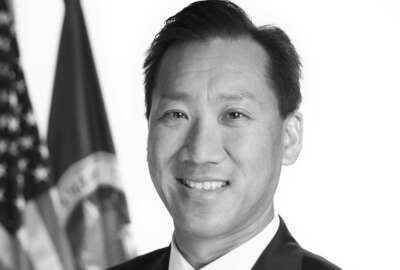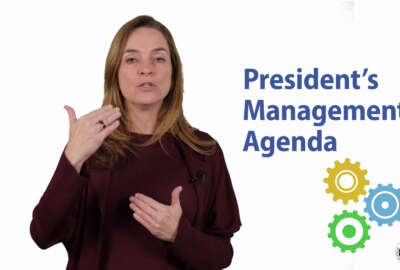
Trump administration to focus in on federal employee performance awards, reskilling in 2019
The Trump administration is also planning to study the full scope of federal employees' pay, benefits other opportunities for recognition, in effort to prove to...
Best listening experience is on Chrome, Firefox or Safari. Subscribe to Federal Drive’s daily audio interviews on Apple Podcasts or PodcastOne.
One year after the release of the President’s Management Agenda, the Trump administration has realized that when it comes to modernizing the federal workforce, it can’t move mountains on its own.
In fact, it may not even be able to move the biggest, most stubborn mountains at all — without taking a few, small steps to bridge the gaps in between.
The Trump administration was in full celebratory mode as it observed the one-year anniversary of the PMA this week.
Many of the concepts or the 14 cross-agency priority goals outlined in the agenda aren’t necessarily new. But the administration sees developments such as the creation of the Federal Cybersecurity Reskilling Academy, the addition of new direct-hire authorities for STEM positions and the focus on standardized training for the acquisition workforce as significant steps forward.
It still sees the existing, decades-old civil service system as the biggest barrier in quickly hiring new talent, filling in-demand positions, managing employees and holding them accountable and compensating them for a job well done.
But in 2019 the administration will double down on the approach it took last year — getting done what it knows it can get done.
“A lot of what we’re doing around the President’s Management Agenda and all of these events is to set the table so that the narrative starts shifting,” Margaret Weichert, acting director of the Office of Personnel Management and deputy director for management at the Office of Management and Budget, said Thursday in an interview. “It isn’t about just what we accomplish right now in this administration. It’s really about changing the dialogue so that the whole community starts to see that the system we have today is untenable.”
The community will be more receptive to some ideas over others, Weichert acknowledged.
Reskilling current, mid-career employees could be one of those ideas that federal unions, for example, could latch onto more easily.
“Reskilling is not code for anything,” Weichert said. “It is literally about getting people aligned to the jobs of the future.”
Weichert said she wouldn’t set a specific target on the number of federal employees who could be reskilled. Instead, she said she’s more focused first on reskilling employees to fill in-demand jobs in IT, cybersecurity and law enforcement.
About 30 percent of work in government today could be automated, Weichert said, citing what’s become a familiar statistic now over the past year. That doesn’t mean 30 percent of federal jobs will disappear with automation, she said. Employees will more often feel the impact of automation in bits and pieces, and the positions themselves will evolve to meet changing agency missions.
Weichert said she has spoken with some federal employee unions about this vision, and at least one organization at one agency is interested in finding options to reskill part of its workforce.
“To me [reskilling] is the one area of common ground that is most urgent for us to find together,” she said. “Frankly, if we don’t do this, the trend right now is when we can’t get the right thing done in government with feds, it gets outsourced. That has a lot of risks not only to the people but also to the mission and to the service quality issues. I don’t think it’s the right long term solution. Contracting is good for a lot of things but we can’t contract away everything.”
A new approach to pay, performance management
The administration’s approach to pay, compensation and performance management, however, may be a tougher sell.
The White House in its recent budget proposal again recommended a freeze in across-the-board pay for federal employees in 2020, reiterating its preference to strategically reward the best performers.
Unlike the previous year, the 2020 request includes no requested appropriation for performance-based bonuses or awards. The Trump administration last year asked for $1 billion as the funding stream to reward top performers.
Instead, the administration is planning to conduct a study of the full scope of benefits, rewards and recognition opportunities that federal employees have, including their pay, retirement, leave and work-life balance programs, Weichert said Wednesday at the National Academy of Public Administration’s PMA anniversary event.
Related Stories

OMB details 14 cross-agency priority goals in unveiling new President’s Management Agenda
In addition, the administration is also planning to make more regulatory changes to incentivize agency managers to find tools other than a paycheck to reward their employees.
Regulatory changes would be designed to give agency heads more authority to reward top employees with bonuses that exceed a certain limit, without having to seek OPM approval first, Weichert said.
Despite frustration from federal employees who are still anxiously awaiting the implementation of the 1.9 percent retroactive pay raise this year, Weichert stands by her belief that the federal workforce itself craves more performance-based pay over an across-the-board raise.
According to the results of the most recent Federal Employee Viewpoint Survey, about 63 percent of the workforce said it’s satisfied with pay, while 25 percent said raises depend on how well they do their jobs.
“We can’t ignore the fact that fiscally how we spend money on people needs to be super thoughtful,” she said in the interview. “To solve the simultaneous equation of achieving more with less, hitting the service levels that Americans expect and doing it in a way that is respectful and fair and merit-based, the only way to thread those needles is to be more judicious about distribution about the population that you have … Are we spending more resources on the squeaky wheels than the absolute stars?”
Copyright © 2025 Federal News Network. All rights reserved. This website is not intended for users located within the European Economic Area.
Nicole Ogrysko is a reporter for Federal News Network focusing on the federal workforce and federal pay and benefits.
Follow @nogryskoWFED




